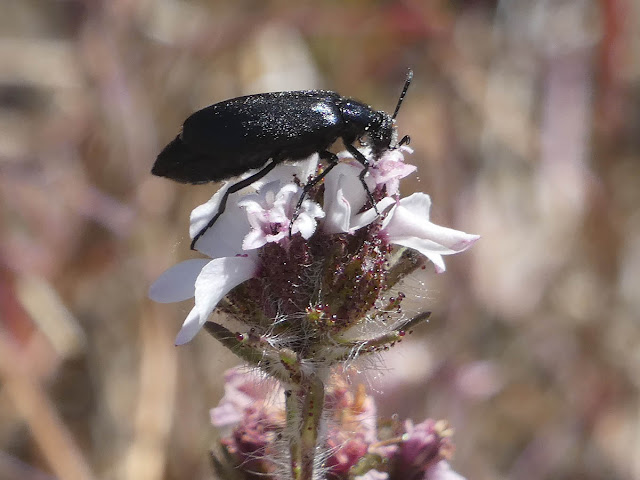 |
| Click to View Larger |
As I said in my last post, I encountered numerous grass species on my ride up Panoramic Highway to Mt. Tamalpais on Thursday. I told myself I'd drive up early Saturday morning to collect a few of them to bring home and photograph, but because I've gotten used to sleeping in now that my wife is on summer break, I wasn't sure I'd actually make the effort. Also, a couple of cats woke us up with a rowdy caterwauling racket last night that sounded like really bad violin-playing. We even got out of bed and went outside to peer through the dense fog to see if Coco, the neighborhood cat who adopted us, was in trouble. I figured the cats would be okay between themselves, but I also hoped they wouldn't attract the attention of a passing coyote.
Despite the interruption, I woke up before six this morning anyway. It was light out already, so I figured I'd roll myself out of bed and get to it. On my second stop I pulled off Panoramic Highway in front of a car that I figured had been parked there all night. I went out and scissored a couple flower heads and the woman in the car poked her head out and asked me if I was collecting wild edibles. Although I believe all grasses are technically edible (i.e., not poisonous), I simply told her I was doing a photo project.
I collected at a few other spots and timed my arrival to coincide with the 7 a.m. opening time at Pantoll gate, but the ranger was a few minutes late and other cars were already waiting ahead of me. Both the Bootjack and Pantoll campgrounds had lots of cars in their lots, and a few campers must have hiked up the road for sunrise. At one point I pulled over near a couple of young women who were walking back down, and they stopped in their tracks. I got out of the car and explained to their obvious relief that I was just collecting grass (the most natural thing in the world, right?).
I put the specimens in a shoe box and separated each species with a length of paper towel. I'm not very handy at identifying grasses and figured I'd collected some of the same species more than once. I'd have been happy to bring home ten species in all, but I was glad to see when I was done that I had nineteen. I checked iNaturalist's Mt. Tam section for a few IDs, but I still wasn't confident enough to hazard many guesses. If they have a grass person who fills in the IDs I'll come back and update this page.
I've always been curious about these strangely flowered plants, but aside from pulling grass seeds out of my socks I have very little interaction with them (not counting the 35 species we eat, like rice, corn, wheat, barley, oats, etc.). I'm sure I lack the patience to learn the nitty-gritty of identifying grasses, but I would like to at least learn the names of our most common species.
 |
| Waiting for the Gate to Open |
* * *





























































